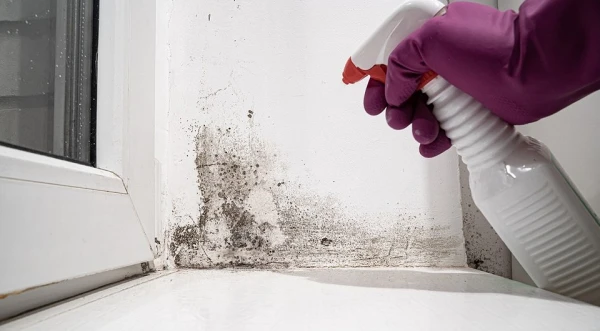
Mold is an uninvited guest that seems frightening but is unfortunately familiar to almost everyone. It appears where it is damp, stuffy, and there is no air circulation: on walls, ceilings, furniture, and in closets. Most often, people panic and rush to throw everything away, but in most cases, it is possible to manage on your own. The main thing is to act wisely, not just to wipe the stain but to eliminate the cause.
Find the Source of Moisture
Mold cannot live without moisture. Start by checking: is the roof leaking, is there a pipe leaking behind the wall, is there condensation collecting on the windows? Sometimes it is enough to raise the temperature in the room or use a dehumidifier. If there is mold on furniture or the wall near the air conditioner, check the drainage pipe, as moisture often accumulates there. Once the source is eliminated, you can proceed to cleaning.
Treat the Surface with Alcohol or Vinegar
Mold is afraid of acidic environments and alcohol. Soak a soft cloth or sponge in 70% medical alcohol and gently wipe the affected area. If you only have vinegar on hand, use it undiluted. After treatment, leave the surface for an hour, then rinse with warm water and dry thoroughly. This method is safe for most materials, except for lacquered ones.
Apply Antiseptics or Hydrogen Peroxide
For stubborn spots, a 3% hydrogen peroxide or pharmacy-grade chlorhexidine will work. Apply the solution from a spray bottle, let it dry, and repeat after a day. You can also use specialized antiseptics for walls—they penetrate deeper and suppress spores. Just do not mix vinegar with chlorine-containing agents: it will produce toxic gas. Work with gloves and with windows open.
Dry and Protect the Surface
After cleaning, it is important to completely remove moisture. A hairdryer, construction dryer, or simply a draft will do. When the area is dry, cover it with antiseptic varnish, a copper sulfate solution, or a special protective primer. This will create a barrier against the reappearance of mold. It is especially effective to treat corners and joints, where mold tends to return most often.
Ventilate and Control Humidity
The main rule of prevention is that air must circulate. Open ventilation grilles, install an exhaust fan, and ventilate more often. If the house is damp, buy a hygrometer: the optimal humidity is 40–60%. If necessary, place a dehumidifier or at least a bowl of coarse salt—it absorbs excess moisture. Regular monitoring of conditions works better than any chemicals: mold simply does not return.
What to Do with Clothes, Toys, and Bedding
If mold has reached your belongings, you need to act quickly—the fungus embeds itself in the fibers and over time becomes a source of allergens. First of all, take everything outside and shake it thoroughly to prevent spores from spreading throughout the house. Light and wind are your first allies: under ultraviolet light, mold dies.
Clothes made of natural fabrics (cotton, linen) should be soaked in hot water with the addition of oxygen bleach or soda (1 tablespoon per liter). After washing, iron the items with a hot steam iron—the high temperature kills any remaining spores. Synthetics and wool should be treated more gently: a vinegar solution (1 part vinegar to 3 parts water) for 30 minutes, then wash with an antiseptic agent.
Soft toys and bedding with visible stains should be washed at a temperature of at least 60°C, if the material allows, and then completely dried in the sun. If the musty smell does not go away, repeat the wash with the addition of a teaspoon of baking soda or a drop of tea tree essential oil. However, items with deep contamination, especially foam toys and pillows, are better replaced—mold cannot be eliminated in their porous layers.















Leave a comment